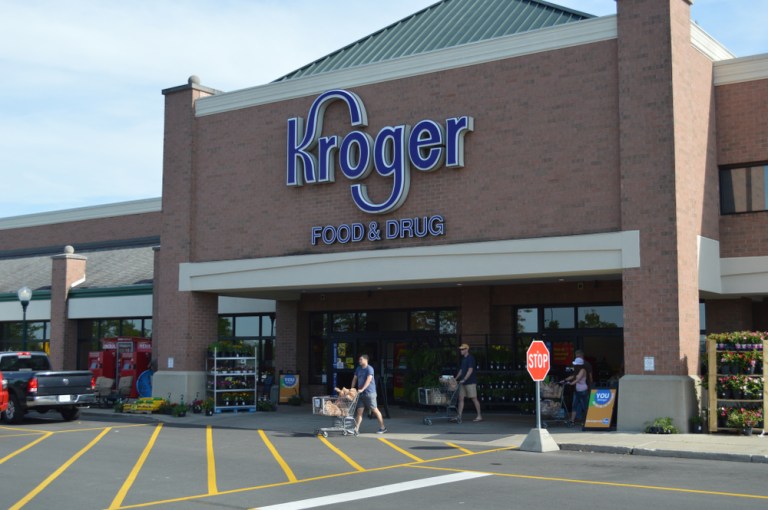
As grocers fight for survival and dominance in the age of Amazon, Kroger is testing connected devices with the help of Microsoft. The retailer plans to pilot technology products using Microsoft’s Azure platform at two stores, one in Ohio and one in Washington. Kroger is seeking to bring new customer experiences to market faster, drive personalization with insights and help store associates become more productive. The effort comes amid a digital push by Kroger through its data-driven Restock Kroger initiative.
In a joint statement with Microsoft, Kroger Chairman and CEO Rodney McMullen said, “Kroger is building a seamless ecosystem driven by data and technology to provide our customers with personalized food inspiration. We are identifying partners through Restock Kroger who will help us reinvent the customer experience and create new profit streams that will also accelerate our core business growth.”
Microsoft CEO Satya Nadella said the companies would “redefine the shopping experience for millions of customers at both Kroger and other retailers around the world.”
With one such experience, Kroger and Microsoft are creating a digital shelving system called the EDGE Shelf. The shelf, which is spelled out as Enhanced Display for Grocery Environment in the statement, uses digital displays in place of paper tags to show prices as well as nutritional and promotion information. According to a Bloomberg description of the system, shoppers at the two pilot stores will be able to use the technology find products on an in-app shopping list. The shelf will show a picture that is set by the shopper, like a banana or a pumpkin. The outlet said the intelligent shelf system could also help workers select items for curbside pickup orders.
Beyond helping workers and shoppers navigate the grocery aisles more efficiently, the EDGE shelf technology is said to pave the way for new revenue opportunities, as it will enable Kroger to sell digital ads to consumer packaged goods (CPG) brands. “Using video analytics, personalized offers and advertisements can be presented based on customer demographics,” the announcement noted. At the same time, Kroger said the experiment “will guide expansion plans in 2019 and beyond.”
The experiment is also said to include other technologies. According to the Bloomberg report, another innovation is “a cross between a camera and a smoke detector” above Kroger’s aisles, which analyzes data and watches for items that are low in inventory. The meat case, too, is said to have technology that alerts staff of warm temperatures that could cause the food inside to expire. All of these efforts come amid a competitive grocery landscape – and Kroger and Amazon both bring unique benefits to the fight.
The Grocery Market
Kroger’s technological innovations come as Amazon is ramping up its grocery efforts with its acquisition of Whole Foods Market last year and the opening of its Amazon Go C-stores, starting with one in Seattle last January. Even so, Kroger has the power of size when it comes to its place in the market for groceries: According to a report last year, it had roughly more than 30,000 stock-keeping units (SKUs) of “exclusive products” and sold a whopping 8.2 billion private-brand products in 2016. At that rate, U.S. shoppers are putting 1.25 million Kroger brand products into their carts every hour of every day that the stores are open.
It was also reported last year that amid Prime Day, Kroger said it sells approximately 110 million items on an average day at its stores. Amazon, by contrast, shipped over 100 million products in the first 24 hours of Prime Day, even with technical difficulties. “It’s easy to take for granted the scale of a company like Kroger,” the grocer said in a statement in July.
Kroger takes in $340 million in revenue on an average day. Amazon, by comparison, was estimated to have taken in $4.2 billion on Prime Day, per one analyst. Amazon, too, has its Prime membership program, which reportedly hit a milestone 100 million subscribers last year.
RBC Capital Markets’ Lead Internet Analyst Mark Mahaney, for instance, pointed out last year that 20 to 30 million people may live close to a Whole Foods store, but may not shop there on an ongoing basis, and there are about 60 to 70 million Prime customers in the U.S. Mahaney told CNBC in June, “[Amazon] could double, theoretically, Whole Foods’ overall customer base over a 5- to 10-year period just by giving financial incentives to Prime customers.”
Kroger is no stranger to technological innovation in the grocery space: The retailer is also testing out deliveries using autonomous vehicles in Arizona with the help of Nuro, and is working with Ocado on grocery delivery (it recently chose the site of a high-tech fulfillment center in November). Will those efforts be enough to counter competitors like Amazon? Future developments will tell, but now, with the latest news, Kroger also has Microsoft on its side.